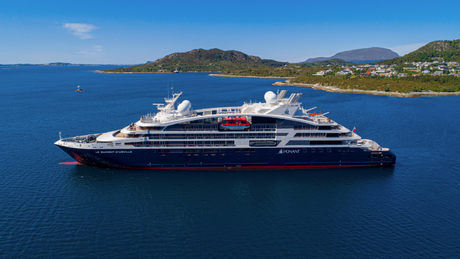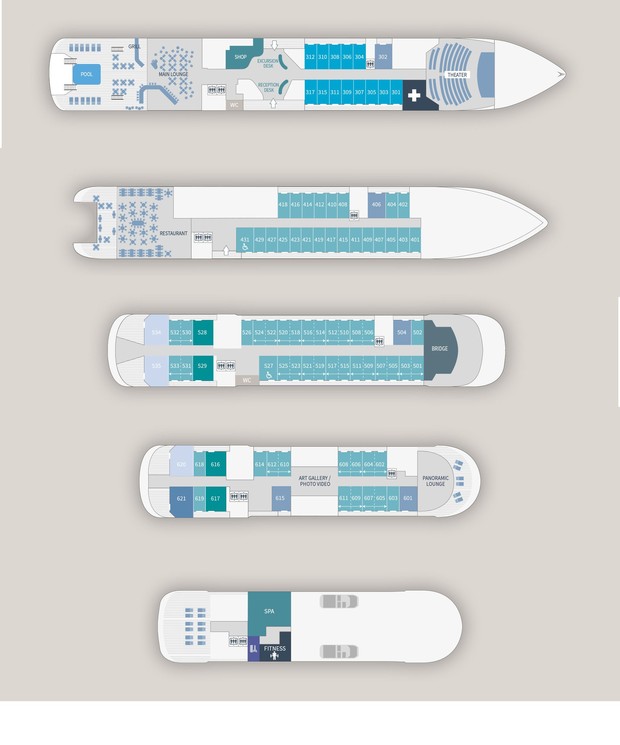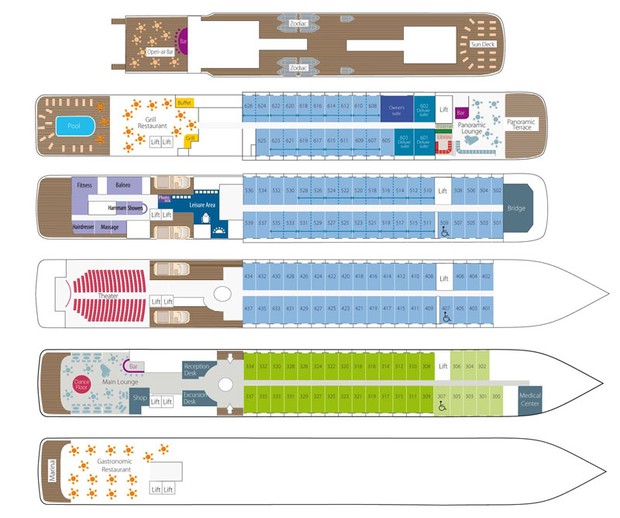
With this brand-new itinerary, join a cruise from Osaka to Fukuoka. This 8-day circuit will allow you to discover the jewels to be found in the picturesque towns and cities of the Seto Inland Sea. The oldest sea route in Japan, a strategic hub during Antiquity, it was also the theatre of many battles and historic events that shaped its myth and grandeur over time with the ebb and flow of the tides.
Le Soléal will set sail from Osaka, a forward-looking modern city, and make its way to the island of Inujima. A flourishing centre of the mining industry more than a century ago, particularly for copper extraction, this small 54-hectare island is now an essential destination for contemporary art enthusiasts. It is notably home to the Seirensho Art Museum, designed around the remaining blackened walls of a former copper refinery.
Aboard one of our zodiac inflatables, you will then head to Tomonoura, known for its gentle way of life and its craggy landscapes, which inspired the artist Hayao Miyazaki for the animated film Ponyo. Then, you will visit Onimichi, a charming coastal town surrounded by green hills and home to a large number of temples and emblematic shrines, including the Senkō-ji, Saikoku-ji, and Jōdo-ji temples.
After calling at Mitarai and Shimokamagari, two traditional fishing villages, Le Soléal will continue its crossing of the Seto Inland Sea to drop anchor on the island of Honshu, in Hagi. The home of the samurai and of Hagi ware will win you over with its narrow streets, traditional houses, and the former residences of the Japanese warriors from this feudal town, of which the mythical Shizuki Castle, erected in the 17th century, emerges as a symbol.
Then, you will sail towards Tsushima, the largest of the Nagasaki islands. Famous for its Aso Bay, offering exceptional panoramas of its ria coast, the island separates the Korean Peninsula from Japan. Eighty-nine percent of it is covered by natural vegetation and mountains. This green setting is the natural habitat of the Tsushima leopard cat, among others.
Outings and shore visits in zodiac inflatables with a team of experienced naturalist guides.
Varied landscapes along the Seto Inland Sea, offering stunning contrasts between land and sea.
Enjoy a local cuisine rich in seafood and taste local saké.
Discover the cultural richness of Japan’s oldest sea route, dating back to the 7th century.
Discover the history, cultures, and the incredible diversity of the flora and fauna thanks to our team of naturalist guides with expertise in this destination.
There are no future departures for this trip at this stage.
Like its big sister Tokyo, Osaka is the product of ancestral traditions and amazing technological innovations. And despite its size, its location on the Pacific Ocean give it a sense of serenity. The main historic landmark is the 16th century Osaka Castle, which stands proud in the midst of majestic skyscrapers. The lively streets of Dotomburi and the bizarre Shinsekai district attract thousands of locals and visitors. A multitude of restaurants offer menus full of regional specialities: takoyaki, made with octopus, and other succulent dishes such as kushikatsu kebabs.
A small verdant island in the Seto Inland Sea, Inujima charms lovers of rugged landscapes and art. A flourishing centre of the mining industry more than a century ago, particularly for copper extraction, the island is now a favourite destination of modern art enthusiasts, due to the activities developed since the 1980s. It is notably home to the Seirensho Art Museum, designed around the remaining blackened walls of a former copper refinery. Inujima offers an ideal mix of wild landscapes, industrial past, and contemporary art. The island will be the perfect port of call for relaxing, enjoying this exceptional panorama, and admiring singular and ambitious works of art.
Anchored to the south-eastern end of the Nunakama Peninsula, facing the calm and clear waters of the Seto Inland Sea, Tomonoura is a destination particularly appreciated for its authentic and old-fashioned atmosphere that gives it an incomparable charm. In the past used as a port where boats would moor while waiting for a favourable wind, the charming and picturesque village now serves to inspire many filmmakers and artists. With good reason, since its craggy landscapes, its cherry trees in blossom, its gentle way of life, its traditional wooden houses and its port, preserved since the Edo era, notably enabled the artist Hayao Miyazaki to make the animated film Ponyo. Anchored on the northern shores of the Seto Inland Sea, in the Hiroshima prefecture, the historical city of Onomichi extends from the main island of Honshu to certain neighbouring islands, linked by the bridges of the Shimanami Kaido motorway. Before becoming this peaceful town with its charming, sloping little streets, Onomichi established itself in the 7th century as a nerve centre of the rice trade for the entire Japanese archipelago. Although its activity is diminished today, the port remains at the centre of the town’s culture. Onomichi now stands out for its exceptional heritage. With good reason, since it can boast over twenty temples and shrines, saved from the bombing of the Second World War. Among them are Senkō-ji, offering an outstanding panoramic view over the whole town, Saikoku-ji and its three-storied pagoda, and Jōdo-ji and its emblematic eleven-faced statue of the goddess Guanyin.
A charming fishing village nestling in the east of Osaki Shimojima Island, on the edge of the Seto Inland Sea, Mitarai is appreciated for its traditional charm and authentic character. A trip back in time to the Edo Period, where the hustle and bustle of modern cities is replaced by the gentle sound of fishing boats. Thanks to its 19th century wooden dwellings lining the small, narrow streets, its great causeway, its centuries-old sanctuaries and its gangi stairs, a stone structure giving on to the sea, the old town was classed as a Preservation District by the Japanese state in 1994. The island of Shimokamagari stretches into the heart of the Seto Inland Sea, off the coast of the town of Kure, in the Hiroshima prefecture. A historical city during the feudal period, the island was the theatre of major diplomatic missions for the future and the Empire’s trade relationships, notably with repeated visits from mainly Korean, but also Chinese and Dutch, emissaries. Registered since 2017 on the UNESCO Memory of the World Programme, documentary heritage of these encounters is conserved in the Shotoen Garden, one of the emblems of this lush islet. A magnificent Japanese garden with perfectly kept grounds, interspersed with raked pebbles and surrounded with majestic trees, it is home to a Rantokaku Museum complex, consisting of four exhibition rooms tracing the island’s naval history.
In the south of Honshu island, surrounded by mountains, Hagi is a city of water. For good reason; it was built on the delta of the Abu-gawa river. Its castle was built in the 17th century and its outer walls remain in the lovely Shizuki Park. The old town was one of the cradles of the Meiji revolution. You will discover its rich past in streets lined with old houses and samurai manors, or within the walls of the many museums and Hagi-yaki ceramics workshops.
A mountainous island nestling in the heart of the Sea of Japan, between the Japanese archipelago and the shores of South Korea, Tsushima is made up of two distinct islands, separated by the captivating Asō Bay. This deep fjord, separating the northern and southern parts of the island, will enthral you with its remarkable ria coastline and its string of luxuriant islets. Naturally preserved, Tsushima is almost 90% covered with natural vegetation. This green setting in the Iki-Tsushima Quasi-National Park is notably the natural habitat of the Tsushima leopard cat, an endemic species on the Japanese Red List of Endangered Species.
Yeosu is a charming coastal city in South Korea’s South Jeolla Province. It is part of an archipelago comprising more than 317 verdant islands. Yeosu is known for being a hidden gem with picturesque scenery, but also for its strong naval history. And with good reason since, in the early 14th century, the city became home to naval headquarters during the Joseon Dynasty. This destination, with a mix of modern architecture and vestiges of a strong past, will enthrall you with its stunning beaches edged by the pure and warm waters of the Sea of Japan.
At the northern tip of the subtropical island of Kyūshū, Fukuoka stands proudly at the centre of a veritable natural setting, between lush mountains and the crystal-clear and calm waters of Hakata Bay. A modern city and high-tech hub, which has earned it the nickame of the Japanese “Silicon Valley” in particular, the seventh town in Japan stands out for its rich cultural and historical heritage. Promoted as one of the nerve centres of maritime trade from the 15th century onward, it experienced long decades of prosperity. A period of splendour which, among other things, saw the construction of many spiritual buildings, including the Sumiyoshi-jinja shrine and the Tochoji temple, as well as its emblematic Maizuru Castle, erected in the 17th century.
Le Jacques Cartier

| Built | 2019 |
|---|---|
| Wheelchair accessible | Yes |
| Lifts/elevators | Yes |
Featuring innovative and environmentally-friendly equipment, elegantly designed staterooms, spacious suites with large windows, and lounge areas that open onto the outside, this new limited-capacity yacht boasting just 92 staterooms and suites will offer you a truly unique cruising experience.
Le Jacques Cartier will embody refinement, intimacy and comfort. Aboard this ship that flies the French flag, you will experience the incomparable pleasure of an intimate cruise, with the possibility of exploring an ever-increasing range of destinations in an ethnic-chic ambiance with luxury service.
Experience a luxurious setting where the accent is on authenticity and passion for travel.
RESTAURANTS
As it is an essential part of French culture, gastronomy will naturally have pride of place aboard this new ship.
To the back of Deck 4, you will find a 260 m² panoramic restaurant which can accommodate all of our passengers in a single sitting. Designed differently to that on our other ships, this dining area, which opens onto the outside, will have a buffet of salads, desserts and cheeses at your disposal. Our discreet and attentive crew will provide table service for hot meals.
In a relaxed atmosphere, an outdoor grill on Deck 3 will serve grilled meats with a variety of salads and desserts.
PUBLIC AREAS
Le Jacques Cartier has many common areas that are designed and equipped to meet all of your needs while preserving the intimacy of each passenger.
A 140 m² reception area includes:
A reception/concierge desk,
An excursions desk,
The ship’s administrative services,
The sales office, manned by our Guest Relations Officer,
Our 50 m² boutique which sells clothing, jewellery, beauty products, postcards and various accessories,
Toilets accessible to passengers with reduced mobility.
A new hydraulic platform with adjustable height provides:
Easier boarding than on any other cruise ship,
Easier Zodiac embarkation and disembarkation for expeditions,
Easier access to the sea for swimming and practising various water sports such as kayaking or paddle-boarding.
A pool deck offering:
A pool with a panoramic view, equipped with a counter-current swimming system,
A pleasant solarium,
An outdoor bar and lounge with armchairs and sofas.
A 200 m² main lounge which can accommodate all of our passengers to share convivial moments and to host activities organised during the day or evening.
Lastly, a theatre that seats 188, equipped with:
The latest sound and lighting technology,
A LED wall as the stage backdrop, for the projection of high-resolution images and videos.
Please click the following links to read more about Ponant and the other Ponant cruise ships.

Le Soleal

| Length | 142 metres |
|---|---|
| Launched | 2013 |
| Crew | 140 |
Luxury Small Ship
A sleek silhouette, a welcoming intimate atmosphere, and the same philosophy that has made her sister ships, L'Austral, Lyrial and Le Boreal, such a success.
This magnificent yacht of only 132 staterooms and suites, all with balconies, has contemporary decor inspired by the luxury yachting world, with fluid lines and a modern colour scheme combining natural wood with shades of grey and white. White Corian counters in the lobby contrast with the warmth of leather to recall a boat's hull, while the central scuplture of enamelled pieces takes its inspiration from the sea. In the lounge bar, the carpet picks up a tennis stripe theme symbolising a certain idea of cruising, one synonomous with French elegance and a chic seaside spirit.
Wheelchairs
3 specially adapted wheelchair cabins (Deck 3 = Superior cabin no. 307, no balcony, Deck 4 = Prestige Cabin no. 407 - with balcony and Deck 5 = Prestige Cabin no 509, with balcony) and lifts to all decks/areas.
Read about our recent Ponant cruise to Antarctica
Please click the following links to read more about Ponant and the other Ponant cruise ships.




